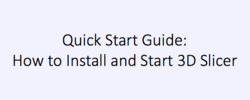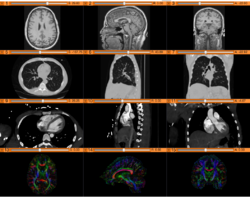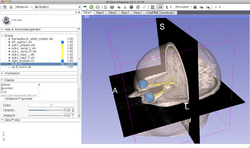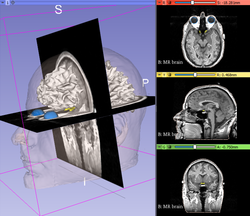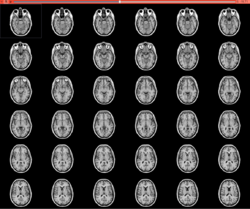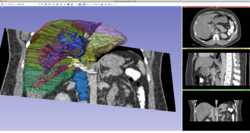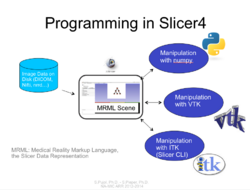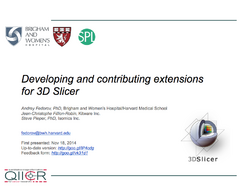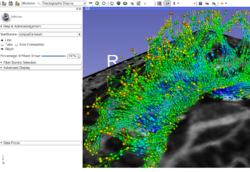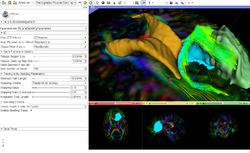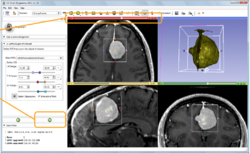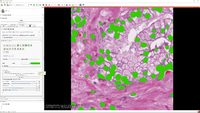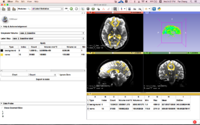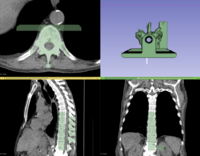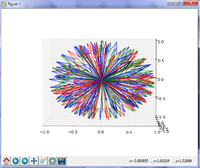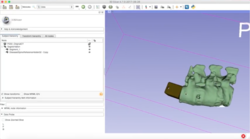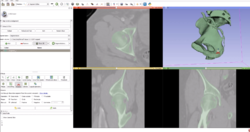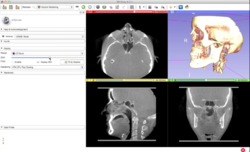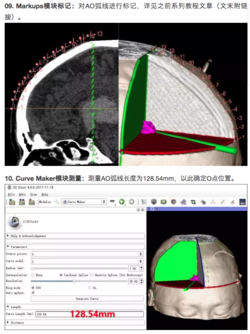Difference between revisions of "Documentation/4.10/Training"
(Nightly -> 4.10) |
|||
| Line 8: | Line 8: | ||
| − | * Some of these tutorials are based on older releases of 3D Slicer. | + | * Some of these tutorials are based on older releases of 3D Slicer and are being upgraded to Slicer4.10. The concepts are still useful but some interface elements and features may be different in updated versions. |
__TOC__ | __TOC__ | ||
| + | |||
| + | =Quick Start Guide = | ||
| + | |||
| + | ==Downloading and Installing Slicer== | ||
| + | {|width="100%" | ||
| + | | | ||
| + | *The [https://www.dropbox.com/s/gtir3x6e007snkx/QuickStartGuide_3DSlicer_SoniaPujol.pdf?dl=0| Quick Start Guide] shows how to install and start 3D Slicer | ||
| + | *Author: Sonia Pujol, Ph.D. | ||
| + | *Based on: 3D Slicer version 4.8 | ||
| + | |align="right"| | ||
| + | [[image:QuickStart_image.png|250px|SlicerWelcome tutorial]] | ||
| + | |} | ||
=General Introduction= | =General Introduction= | ||
| Line 17: | Line 29: | ||
{|width="100%" | {|width="100%" | ||
| | | | ||
| − | *The [ | + | *The [https://www.dropbox.com/s/vn8sqlof2kag2kk/SlicerWelcome-tutorial_Slicer4.8_SoniaPujol.pdf?dl=0] is an introduction to Slicer. |
*Author: Sonia Pujol, Ph.D. | *Author: Sonia Pujol, Ph.D. | ||
| − | *Audience: First time users who want a general introduction to the software | + | *Audience: First-time users who want a general introduction to the software |
*Modules: Welcome to Slicer, Sample Data | *Modules: Welcome to Slicer, Sample Data | ||
| − | *Based on: 3D Slicer version 4. | + | *Based on: 3D Slicer version 4.8 |
|align="right"| | |align="right"| | ||
[[image:SlicerWelcome-image.png|250px|SlicerWelcome tutorial]] | [[image:SlicerWelcome-image.png|250px|SlicerWelcome tutorial]] | ||
| Line 29: | Line 41: | ||
{|width="100%" | {|width="100%" | ||
| | | | ||
| − | *The [ | + | *The [https://www.dropbox.com/s/9jfsyhhgude5hf1/Slicer4.8minute_SoniaPujol.pdf?dl=0| Slicer4 Minute Tutorial] is a brief introduction to the advanced 3D visualization capabilities of Slicer 4.8. |
*Author: Sonia Pujol, Ph.D. | *Author: Sonia Pujol, Ph.D. | ||
| − | *Audience: First time users who want to discover Slicer in 4 minutes | + | *Audience: First-time users who want to discover Slicer in 4 minutes |
*Modules: Welcome to Slicer, Models | *Modules: Welcome to Slicer, Models | ||
| − | *Based on: 3D Slicer version 4. | + | *Based on: 3D Slicer version 4.8 |
*The [[media:Slicer4minute.zip|Slicer4Minute dataset]] contains an MR scan of the brain and 3D reconstructions of the anatomy | *The [[media:Slicer4minute.zip|Slicer4Minute dataset]] contains an MR scan of the brain and 3D reconstructions of the anatomy | ||
|align="right"| | |align="right"| | ||
| Line 39: | Line 51: | ||
|} | |} | ||
| + | =3D Visualization= | ||
==Slicer4 Data Loading and 3D Visualization == | ==Slicer4 Data Loading and 3D Visualization == | ||
{|width="100%" | {|width="100%" | ||
| Line 62: | Line 75: | ||
[[Image:Slicer4DataLoading_tutorial.png|right|250px|]] | [[Image:Slicer4DataLoading_tutorial.png|right|250px|]] | ||
|} | |} | ||
| + | |||
| + | ==Slicer4 3D Visualization of DICOM images for Radiology Applications== | ||
| + | {|width="100%" | ||
| + | | | ||
| + | *The [https://www.dropbox.com/s/9jcjpl33qfh5pi6/3DVisualizationDICOM_Slicer4.8_SoniaPujol.pdf?dl=0 3D Visualization of DICOM images] course guides through 3D data loading and visualization of DICOM images for Radiology Applications in Slicer4. | ||
| + | *Author: Sonia Pujol, Ph.D., Kitt Shaffer, M.D., Ph.D., Ron Kikinis, M.D. | ||
| + | *Audience: Radiologists and users of Slicer who need a more comprehensive overview over Slicer4 visualization capabilities. | ||
| + | *Modules: DICOM, Volumes, Volume Rendering, Models. | ||
| + | *Based on: 3D Slicer version 4.8 | ||
| + | *The [[Media:3DVisualization_DICOM_images_part1.zip | 3DVisualizationDICOM_part1]] and [[Media:3DVisualization_DICOM_images_part2.zip | 3DVisualizationDICOM_part2]] datasets contain a series of MR and CT scans, and 3D models of the brain, lung and liver. | ||
| + | |align="right"| | ||
| + | [[Image:Slicer4RSNA_2.png|right|250px|]] | ||
| + | |} | ||
| + | |||
| + | == DICOM == | ||
| + | |||
| + | {|width="100%" | ||
| + | | | ||
| + | * DICOM export: '''[https://youtu.be/nzWf4xHy1BM Export CT and segmentation to DICOM - video tutorial]''' | ||
| + | * Author: Andras Lasso, Csaba Pinter. | ||
| + | * Dataset: CTChest sample data in Slicer. | ||
| + | * Based on Slicer 4.9 | ||
| + | |align="right"| | ||
| + | <!-- [[Image:TUTORIAL-IMAGE-HERE.png|right|150px|]] --> | ||
| + | |} | ||
| + | |||
=Tutorials for software developers= | =Tutorials for software developers= | ||
| Line 90: | Line 129: | ||
|} | |} | ||
| − | = | + | =Segmentation= |
| + | == Slicer4 Image Segmentation == | ||
| + | |||
| + | {|width="100%" | ||
| + | | | ||
| + | * Segmentation for 3D printing: shows how to use the Segment Editor module for combining CAD designed parts with patient-specific models. | ||
| + | ** '''[[Documentation/{{documentation/version}}/Training#Segmentation_for_3D_printing|Segmentation for 3D printing Step-by-step tutorial]]'''. Author: Csaba Pinter, MSc | ||
| + | ** Audience: Users and developers interested in segmentation and 3D printing | ||
| + | ** Based on: 3D Slicer version 4.7 | ||
| + | |align="right"|[[Image:20170717_3DPrintingTutorialYoutube.PNG|280px]] | ||
| + | |--- | ||
| + | | | ||
| + | * '''[https://youtu.be/BJoIexIvtGo Video tutorial: Whole heart segmentation from cardiac CT]''' shows how to use the Segment Editor module for segmenting heart ventricles, atria, and great vessels from cardiac CT volumes. | ||
| + | ** Author: Andras Lasso, PhD | ||
| + | ** Audience: Users who need to segment heart structures, for example for visualization, quantification, or simulation. | ||
| + | ** [http://slicer.kitware.com/midas3/download/bitstream/738905/CTA-cardio2.nrrd Sample data set] | ||
| + | ** Based on: 3D Slicer version 4.8 | ||
| + | |align="right"|[[Image:WholeHeartSegYoutube.png|280px]] | ||
| + | |} | ||
| + | |||
| + | =Registration= | ||
| + | |||
| + | == Slicer4 Image Registration == | ||
| + | |||
| + | {|width="100%" | ||
| + | | | ||
| + | *The [https://www.dropbox.com/s/chrugp2j2as5gop/ImageRegistration_Slicer4.8_SoniaPujol.pdf?dl=0 Registration tutorial] shows how to perform intra- and inter-subject registration within Slicer. | ||
| + | * Authors: Sonia Pujol, Ph.D., Dominik Meier, Ph.D., Ron Kikinis, M.D. | ||
| + | * Audience: Users and developers interested in image registration | ||
| + | * Dataset: [[Media:RegistrationData.zip| 3D Slicer Registration Data]] | ||
| + | |align="right"|[[File:registration_Slicer4.png|250px]] | ||
| + | |} | ||
| + | *Based on: 3D Slicer version 4.8 | ||
| + | |||
| + | == Slicer Registration Case Library== | ||
| + | {|width="100%" | ||
| + | | | ||
| + | *The ''[[Documentation/{{documentation/version}}/Registration/RegistrationLibrary|Slicer Registration Case Library]]'' provides real-life example cases of using the Slicer registration tools. They include pre-computed dataset and step-by-step instructions for users to follow. | ||
| + | :Author: Dominik Meier, Ph.D. | ||
| + | :Audience: users interested learning/applying Slicer image registration technology | ||
| + | |align="right"|[[Image:RegLib_table.png|250px|link=http://wiki.slicer.org/slicerWiki/index.php/Documentation/{{documentation/version}}/Registration/RegistrationLibrary]] | ||
| + | |} | ||
| + | =Slicer Extensions= | ||
==Slicer4 Diffusion Tensor Imaging Tutorial == | ==Slicer4 Diffusion Tensor Imaging Tutorial == | ||
{|width="100%" | {|width="100%" | ||
| | | | ||
*Please visit [http://dmri.slicer.org/docs/ dmri.slicer.org/docs] for the latest documentation of SlicerDMRI. | *Please visit [http://dmri.slicer.org/docs/ dmri.slicer.org/docs] for the latest documentation of SlicerDMRI. | ||
| − | *The [https:// | + | *The [https://www.dropbox.com/s/m7rzeblbdzr49bc/DiffusionMRIAnalysis_Slicer4.8_SoniaPujol.pdf?dl=0| Diffusion Tensor Imaging] course is an introduction to the basics of loading Diffusion Weighted images in Slicer, estimating tensors and generating fiber tracts. |
*Author: Sonia Pujol, Ph.D. | *Author: Sonia Pujol, Ph.D. | ||
*Audience: End-users and developers | *Audience: End-users and developers | ||
*Modules: Data, Volumes, DWI to DTI Estimation, Diffusion Tensor Scalar Measurements, Editor, Markups,Tractography Label Map Seeding, Tractography Interactive Seeding | *Modules: Data, Volumes, DWI to DTI Estimation, Diffusion Tensor Scalar Measurements, Editor, Markups,Tractography Label Map Seeding, Tractography Interactive Seeding | ||
| − | *Based on: 3D Slicer version 4. | + | *Based on: 3D Slicer version 4.8 |
*The [[media:Dti tutorial data.zip|DTI dataset]] contains an MR Diffusion Weighted Imaging scan of the brain. | *The [[media:Dti tutorial data.zip|DTI dataset]] contains an MR Diffusion Weighted Imaging scan of the brain. | ||
|align="right"| | |align="right"| | ||
| Line 110: | Line 191: | ||
| | | | ||
*Please visit [http://dmri.slicer.org/docs/ dmri.slicer.org/docs] for the latest documentation of SlicerDMRI. | *Please visit [http://dmri.slicer.org/docs/ dmri.slicer.org/docs] for the latest documentation of SlicerDMRI. | ||
| − | *The [http://dmri.slicer.org/tutorials/ | + | *The [http://dmri.slicer.org/tutorials/Slicer-4.8/WhiteMatterExplorationTutorial.pdf Neurosurgical Planning tutorial] course guides through the generation of fiber tracts in the vicinity of a tumor. |
*Author: Sonia Pujol, Ph.D., Ron Kikinis, M.D. | *Author: Sonia Pujol, Ph.D., Ron Kikinis, M.D. | ||
*Audience: End-users and developers | *Audience: End-users and developers | ||
*Modules: Volumes, Editor, Tractography Label Map Seeding, Tractography Interactive Seeding | *Modules: Volumes, Editor, Tractography Label Map Seeding, Tractography Interactive Seeding | ||
*Based on: 3D Slicer version 4.6 | *Based on: 3D Slicer version 4.6 | ||
| − | *The [[Media:WhiteMatterExplorationData.zip| White Matter Exploration | + | *The [[Media:WhiteMatterExplorationData.zip| White Matter Exploration dataset]] contains a Diffusion Weighted Imaging scan of brain tumor patient. |
|align="right"| | |align="right"| | ||
[[Image:NeurosurgicalPlanningTutorial.png|right|250px|link=http://vimeo.com/67336069]] | [[Image:NeurosurgicalPlanningTutorial.png|right|250px|link=http://vimeo.com/67336069]] | ||
|} | |} | ||
| − | + | ||
| − | |||
| − | |||
| − | |||
| − | |||
| − | |||
| − | |||
| − | |||
| − | |||
| − | |||
| − | |||
| − | |||
==Slicer4 Quantitative Imaging tutorial== | ==Slicer4 Quantitative Imaging tutorial== | ||
| Line 159: | Line 229: | ||
|} | |} | ||
| − | == Slicer4 | + | |
| + | ==Slicer4 Radiation Therapy Tutorial == | ||
{|width="100%" | {|width="100%" | ||
| | | | ||
| − | * | + | * The [https://github.com/SlicerRt/SlicerRtDoc/raw/master/tutorials/SlicerRT_WorldCongress_TutorialIGRT.pdf SlicerRT tutorial] is an introduction to the Radiation Therapy functionalities of Slicer. |
| − | + | * Author: Csaba Pinter, Andras Lasso, An Wang, Gregory C. Sharp, David Jaffray, Gabor Fichtinger. | |
| − | + | * Dataset: [http://slicer.kitware.com/midas3/download/item/205404/SlicerRT_WorldCongress_TutorialIGRT_Dataset.zip download] from MIDAS server | |
| − | + | * Based on Slicer 4.7 | |
| − | + | |align="right"| | |
| − | + | <!-- [[Image:TUTORIAL-IMAGE-HERE.png|right|150px|]] --> | |
| − | |||
| − | |||
| − | |||
| − | |||
| − | |||
| − | |||
| − | * | ||
| − | |||
| − | |align="right"| | ||
| − | |||
| − | |||
| − | |||
| − | |||
| − | |||
| − | |||
| − | |||
| − | | | ||
| − | |||
| − | |||
| − | |||
|} | |} | ||
| − | |||
| + | ==Slicer Pathology== | ||
{|width="100%" | {|width="100%" | ||
| | | | ||
| − | *The [ | + | *The [[Documentation/{{documentation/version}}/Extensions/SlicerPathology|Slicer Pathology Tutorial]] describes how to use the corresponding tools for automatic and semi-automatic pathology image segmentation. |
| − | * | + | *Author: Erich Bremer (Stonybrook), Andriy Fedorov (Brigham and Women’s Hospital) |
| − | + | *Dataset: Available directly with the Slicer Pathology Slicer extension. | |
| − | * Dataset: | + | |align="right"| |
| − | |align="right"|[[File: | + | [[File:SlicerPathologyScreenShot8.png | 200px]]. |
|} | |} | ||
| − | |||
| − | |||
| − | |||
| − | |||
| + | ==SPHARM-PDM== | ||
{|width="100%" | {|width="100%" | ||
| | | | ||
| − | * The | + | *The [https://www.nitrc.org/docman/view.php/308/1982/SPHARM-PDM_Tutorial_July2015.pdf SPHARM-PDM Tutorial] describes how to use SPHARM-PDM and ShapePopulationViewer Slicer extensions to respectively compute point-based models using a parametric boundary description for the computing of Shape Analysis and perform the quality control between the different models. |
| − | * Author: | + | *Author: Jonathan Perdomo (UNC), Beatriz Paniagua (Kitware Inc.) |
| − | * Dataset: [ | + | *Dataset: [https://www.nitrc.org/docman/view.php/308/1981/SPHARM_Tutorial_Data_July2015.zip Tutorial Data] |
| − | |||
|align="right"| | |align="right"| | ||
| − | + | [[File:SlicerWinterProjectWeek2017-SPHARM-PDM.png | 200px]]. | |
|} | |} | ||
| − | == | + | ==Fiber Bundle Volume Measurement== |
| − | |||
{|width="100%" | {|width="100%" | ||
| | | | ||
| − | * | + | *The [http://www.na-mic.org/Wiki/images/5/57/Fiber_Bundle_Volume_Measurement.pptx Fiber Bundle Volume Measurement Tutorial] aim is to calculate the volume of the fiber bundle that passes through the Corpus Callosum(CC). Following this tutorial, you’ll be able to (1) convert fiber bundles to label map and (2) calculate volume measurements from the fiber bundles. |
| − | * Author: | + | *Author: Shun Gong (Shanghai Changzheng Hospital, China) |
| − | * Dataset: | + | *Dataset: [http://www.na-mic.org/Wiki/images/4/4c/FiberVolume_data.zip Tutorial data]: The following data are provided: Baseline image, Down sampled whole brain tractography (conducted as in the [[Documentation/{{documentation/version}}/Training#Slicer4_Diffusion_Tensor_Imaging_Tutorial|DWI tutorial]] and down-sampled to about 10000 fibers using Tractography Display module), Corpus callosum label map (drawn as in the [[Documentation/{{documentation/version}}/Training#Slicer4_Diffusion_Tensor_Imaging_Tutorial|DWI tutorial]]). |
| − | |||
|align="right"| | |align="right"| | ||
| − | + | [[File:SlicerWinterProjectWeek2017-FiberBundleVolumeMeasurements.png | 200px]]. | |
|} | |} | ||
| − | = | + | = 3D Slicer version 4.7 Tutorial Contest= |
| − | + | For previous editions of the contest, please visit the [https://na-mic.org/wiki/Tutorial_Contests 3D Slicer Tutorial Contests page] | |
| − | |||
| − | |||
| − | |||
| − | |||
===Segmentation for 3D printing=== | ===Segmentation for 3D printing=== | ||
| Line 297: | Line 338: | ||
|} | |} | ||
| − | = | + | =YouTube videos= |
| − | |||
| − | |||
| − | |||
| − | |||
| − | |||
| − | |||
| − | |||
| − | |||
| − | |||
| − | |||
| − | |||
| − | |||
| − | |||
| − | |||
| − | |||
| − | |||
| − | |||
| − | |||
| − | |||
| − | |||
| − | |||
| − | |||
| − | |||
| − | |||
| − | |||
| − | |||
| − | |||
| − | |||
| − | |||
| − | |||
| − | |||
| − | |||
| − | |||
| − | |||
| − | |||
| − | |||
| − | |||
| − | |||
| − | |||
| − | |||
| − | |||
| − | |||
| − | |||
| − | |||
| − | |||
| − | |||
| − | |||
| − | |||
| − | |||
| − | |||
| − | |||
| − | === | + | {| border="1" cellpadding="5" width="1200px" |
| − | + | | style="width:33%" | [[Image:Verterbra.png|right|250px|]] [https://www.youtube.com/watch?v=Uht6Fwtr9hE How to segment multiple vertebrae in spine CT for 3D printing - Author: Hillary Lia] | |
| − | | | + | | style="width:33%" | [[Image:Femurmodel.png|right|250px|]] [https://www.youtube.com/watch?v=0at15gjk-Ns Creating a femur model from CT volume using 3D Slicer - Author: Nabgha Farhat ] |
| − | + | | style="width:33%" | [[Image:3DPrinting.png|right|250px|]] [https://www.youtube.com/watch?v=MKLWzD0PiIc Preparing data for 3D printing - Author: PerkLab ] | |
| − | + | |- | |
| − | |||
| − | | | ||
| − | [[Image: | ||
|} | |} | ||
| − | == | + | Additional [http://www.youtube.com/results?search_query=3d+slicer&sm=3 non-curated videos-based demonstrations using 3D Slicer are accessible on YouTube]. |
| − | = | + | =Teams Contributions = |
| − | |||
| − | |||
| − | |||
| − | |||
| − | |||
| − | |||
| − | |||
| − | |||
| − | |||
| − | |||
| − | |||
| − | |||
| − | |||
| − | |||
| − | |||
| − | |||
| − | |||
| − | |||
| − | |||
| − | |||
| − | |||
| − | |||
| − | |||
| − | |||
| − | |||
| − | |||
| − | |||
| − | |||
| − | |||
| − | |||
| − | |||
| − | |||
| − | |||
| − | |||
| − | |||
| − | |||
| − | |||
| − | |||
| − | |||
| − | |||
| − | |||
| − | |||
| − | |||
| − | |||
| − | |||
| − | |||
| − | |||
| − | |||
| − | |||
| − | |||
| − | |||
| − | |||
| − | |||
| − | |||
| − | |||
| − | |||
| − | |||
| − | |||
| − | |||
| − | |||
| − | |||
| − | |||
| − | |||
| − | |||
| − | |||
| − | |||
| − | |||
| − | |||
| − | |||
| − | |||
| − | |||
| − | |||
| − | |||
| − | |||
| − | |||
| − | |||
| − | |||
| − | |||
| − | |||
| − | |||
| − | |||
| − | |||
| − | |||
| − | |||
| − | |||
| − | |||
| − | |||
| − | |||
{|width="100%" | {|width="100%" | ||
| | | | ||
| Line 474: | Line 373: | ||
---- | ---- | ||
<br> | <br> | ||
| − | + | == International resources== | |
| − | |||
| − | |||
| − | |||
| − | |||
| − | |||
| − | |||
| − | |||
| − | = | ||
| − | |||
| − | |||
| − | |||
| + | ==Resources in Chinese == | ||
{|width="100%" | {|width="100%" | ||
| | | | ||
| Line 507: | Line 396: | ||
|} | |} | ||
| − | == Resources in German == | + | ==Resources in German == |
* [https://www.youtube.com/watch?v=sl-00kGpuPk&list=PLJWCUXz3GeAfmYLiFcKus_c0jcsMnVsgb A series of four YouTube videos on python programming in Slicer] (German narration with English subtitles) | * [https://www.youtube.com/watch?v=sl-00kGpuPk&list=PLJWCUXz3GeAfmYLiFcKus_c0jcsMnVsgb A series of four YouTube videos on python programming in Slicer] (German narration with English subtitles) | ||
| Line 540: | Line 429: | ||
* [http://openpaleo.blogspot.com/2009/03/3d-slicer-tutorial-part-v.html Open Source Paleontologist: 3D Slicer: The Tutorial Part V] | * [http://openpaleo.blogspot.com/2009/03/3d-slicer-tutorial-part-v.html Open Source Paleontologist: 3D Slicer: The Tutorial Part V] | ||
* [http://openpaleo.blogspot.com/2009/03/3d-slicer-tutorial-part-vi.html Open Source Paleontologist: 3D Slicer: The Tutorial Part VI] | * [http://openpaleo.blogspot.com/2009/03/3d-slicer-tutorial-part-vi.html Open Source Paleontologist: 3D Slicer: The Tutorial Part VI] | ||
| − | |||
| − | |||
| − | |||
| − | |||
| − | |||
| − | |||
| − | |||
| − | |||
Revision as of 13:56, 24 October 2018
Home < Documentation < 4.10 < Training
|
For the latest Slicer documentation, visit the read-the-docs. |
Introduction: Slicer 4.10 Tutorials
- This page contains "How to" tutorials with matched sample data sets. They demonstrate how to use the 3D Slicer environment (version 4.10 release) to accomplish certain tasks.
- For tutorials for other versions of Slicer, please visit the Slicer training portal.
- For "reference manual" style documentation, please visit the Slicer 4.10 documentation page
- For questions related to the Slicer4 Training Compendium, please send an e-mail to Sonia Pujol, Ph.D., Director of Training of 3D Slicer.
- Some of these tutorials are based on older releases of 3D Slicer and are being upgraded to Slicer4.10. The concepts are still useful but some interface elements and features may be different in updated versions.
Contents
Quick Start Guide
Downloading and Installing Slicer
|
General Introduction
Slicer Welcome Tutorial
|
Slicer4Minute Tutorial
|
3D Visualization
Slicer4 Data Loading and 3D Visualization
|
Slicer4 3D Visualization of DICOM images for Radiology Applications
|
DICOM
|
Tutorials for software developers
Slicer4 Programming Tutorial
|
For additional Python scripts examples, please visit the Script Repository page
Developing and contributing extensions for 3D Slicer
|
Segmentation
Slicer4 Image Segmentation
|
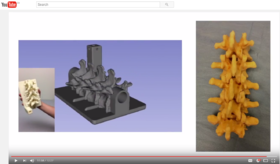
|
|
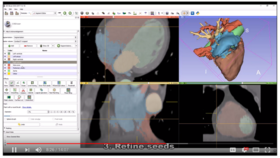
|
Registration
Slicer4 Image Registration
|
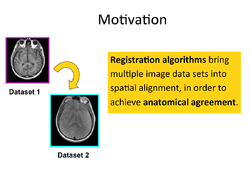
|
- Based on: 3D Slicer version 4.8
Slicer Registration Case Library
|
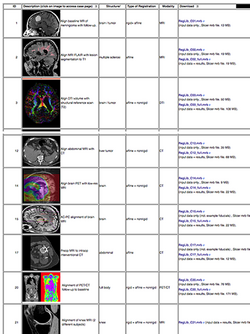
|
Slicer Extensions
Slicer4 Diffusion Tensor Imaging Tutorial
|
Slicer4 Neurosurgical Planning Tutorial
|
Slicer4 Quantitative Imaging tutorial
|
Slicer4 IGT
|
Slicer4 Radiation Therapy Tutorial
|
Slicer Pathology
|
SPHARM-PDM
|
Fiber Bundle Volume Measurement
|
3D Slicer version 4.7 Tutorial Contest
For previous editions of the contest, please visit the 3D Slicer Tutorial Contests page
Segmentation for 3D printing
|
Slicer Pathology
|
Simple Python Tool for Quality Control of DWI data
|
SPHARM-PDM
|
Integration of Robot Operating System (ROS) and 3D Slicer using OpenIGTLink
|
Fiber Bundle Volume Measurement
|
YouTube videos
Additional non-curated videos-based demonstrations using 3D Slicer are accessible on YouTube.
Teams Contributions
|
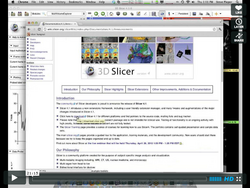
|
|
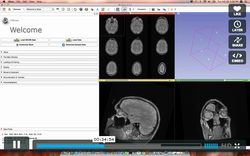
|
International resources
Resources in Chinese
|
A 3D Slicer community on WeChat in China offers many tutorials and clinical examples in Chinese. Note that the images are of interest to non-Chinese speakers and Google Translate does a reasonable job of translating some of the text. |
Resources in German
- A series of four YouTube videos on python programming in Slicer (German narration with English subtitles)
Murat Maga's blog posts about using 3D Slicer for biology
Using the (legacy) Editor
Fast GrowCut
|

|
Use case: Slicer in paleontology
This set of tutorials about the use of slicer in paleontology is very well written and provides step-by-step instructions. Even though it covers slicer version 3.4, many of the concepts and techniques have applicability to the new version and to any 3D imaging field:
- Open Source Paleontologist: 3D Slicer: The Tutorial
- Open Source Paleontologist: 3D Slicer: The Tutorial Part II
- Open Source Paleontologist: 3D Slicer: The Tutorial Part III
- Open Source Paleontologist: 3D Slicer: The Tutorial Part IV
- Open Source Paleontologist: 3D Slicer: The Tutorial Part V
- Open Source Paleontologist: 3D Slicer: The Tutorial Part VI
